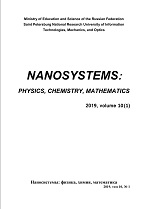|
PHYSICS
Assessment of structural changes in proteins and surrounding water molecules in solution according to SAXS and MD data
Alexander V. Smirnova, Andrei M. Semenovbc, Yuri B. Porozovde, Boris A. Fedorova
a ITMO University, Saint Petersburg 197101, Russia
b Alferov University Russian Academy of Sciences, Saint Petersburg 194021, Russia
c Voronezh State University, Voronezh 394018, Russia
d Sechenov First Moscow State Medical University, Moscow 119991, Russia
e Sirius University of Science and Technology, Sochi 354340, Russia
Abstract:
The SASPAR program for calculation of SAXS of proteins in solution uses trajectories of molecular dynamics (MD) and an explicit solvent model. The program allows one to take into account real interactions of solvent molecules both between each other and with the protein molecule. The previously developed SAS-CUBE program (the “cube method”) is also used, it assumes that the protein structures in crystal and in solution coincide, and the water surrounding the proteins is considered as a homogeneous continuum. Using these programs, SAXS curves were calculated for 18 proteins of different molecular weights and then compared with one another and with the corresponding experimental scattering curves. “Vacuum” SAXS curves (i.e., without taking into account the surrounding water) were also calculated for each protein for two approaches: a) based on the coordinates of protein atoms in crystal and b) based on the coordinates of protein atoms for each MD frame with further averaging of the intensities from all the frames. 1) It was shown that for the 14 single-domain proteins considered, the “vacuum” scattering curves calculated by two methods coincide well for almost each protein. Hence, the structure of the studied proteins in a solution is similar to their structure in a crystal and, therefore, the presence of the surrounding water molecules does not alter the protein structure itself signi cantly. The SASPAR- and SASCUBE-curves coincide well only in two cases (i.e., water is only slightly structured near the protein surface), but in the other cases these curves are markedly different, which indicates the structuredness of the water near the protein surface, although to a different extent. 2) It was shown that for the 4 multi-domain proteins considered, their “vacuum” scattering curves, calculated with the two methods indicated above, differ noticeably, which is an evidence that their crystalline and “water” structures are different. It was also shown that the most of the calculated curves coincide well with the experimental ones.
Keywords:
small-angle X-ray solution scattering, molecular dynamics, protein structure in solution, water structure.
Received: 12.04.2022
Revised: 14.04.2022
Citation:
Alexander V. Smirnov, Andrei M. Semenov, Yuri B. Porozov, Boris A. Fedorov, “Assessment of structural changes in proteins and surrounding water molecules in solution according to SAXS and MD data”, Nanosystems: Physics, Chemistry, Mathematics, 13:3 (2022), 274–284
Linking options:
https://www.mathnet.ru/eng/nano1108 https://www.mathnet.ru/eng/nano/v13/i3/p274
|

| Statistics & downloads: |
| Abstract page: | 58 | | Full-text PDF : | 38 |
|




 Contact us:
Contact us: Terms of Use
Terms of Use
 Registration to the website
Registration to the website Logotypes
Logotypes








 Citation in format
Citation in format 